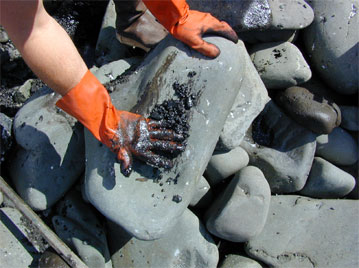

Habitat Assessment and Marine Chemistry: Contaminants and Oil
 |
Exxon Valdez oil in Prince William Sound. |
| |
In partnership with local citizens’ groups and local, state,
and other federal agencies, the Habitat Assessment and Marine Chemistry Program
provides research results for rationally minimizing habitat loss caused by oil
development and other pollution-generating activities by quantifying
contaminant threats to reproductive, nursery, and feeding habitats for various
life stages of federally managed fish species.
Results have been instrumental in shaping legislation
(MARPOL Annex V, regulation of bottom paints, and Tongass Timber Reform Act) as
well as litigation related to the Exxon Valdez Oil Spill. Research on the role of hydrocarbons has
altered our understanding of the role of these persistent and toxic chemicals
on fish reproduction, resulting in increasingly stringent water quality
standards both regionally and nationally.
Habitat Assessment researchers have been involved since day
one in evaluating the impacts of the Exxon Valdez Oil Spill (EVOS).
The Exxon Valdez spill took place on March 24, 1989
when the tanker ran aground on Bligh Reef, spilling 11 million gallons of crude oil into
Prince William Sound, Alaska. Primary research themes focus on
the long-term persistence of oil and the effects of oil on species not yet
recovered from the EVOS. Our staff is also responsible for maintaining the
EVOS hydrocarbon database, which contains all of the Trustee's hydrocarbon data
since 1989 for all agency projects.
Key Publications to this Research
Heintz, Ron, Margaret M. Krahn, Gina M. Ylitalo, and Frank Morado. 2006. Organochlorines in walleye pollock from the Bering Sea and southeastern Alaska. Pp. 561-580 in: A.W. Trites, S.K. Atkinson, D.P. DeMaster, L.W. Fritz, T.S. Gelatt, L.D. Rea, and K.M. Wynne (eds.). Sea Lions of the World. Alaska Sea Grant College Program Publication AK-SG-06-01, University of Alaska Fairbanks, Fairbanks, Alaska.
Peterson, C. H., S. D. Rice, J. W. Short, D. Esler, J. L. Bodkin, B. E. Ballachey, and D. B. Irons. 2003. Long‑term ecosystem response to the Exxon Valdez oil spill. Science 302: 2082‑2086.
Rice, Stanley D., Jeffrey W. Short, Mark G. Carls, Adam Moles, and Robert B. Spies. In Press. The Exxon Valdez oil spill. Pp. 413-514 in: R.B. Spies, T. Cooney, A.M. Springer, T. Weingartner, and G. Kruse (eds.), Long-term Ecological Change in the Northern Gulf of Alaska. Elsevier Publications, Amsterdam.
Related Links:
EVOS Trustee Council
NMFS Office of Exxon Valdez Oil Spill Damage Assessment and
Restoration
NOAA Office of Response and Restoration
Prince William Sound Oil Spill Recovery Institute
Prince William Sound Regional Citizens’ Advisory Council
Cook Inlet Regional Citizens’ Advisory Council
|